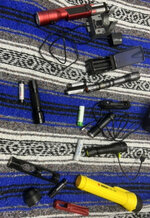I see many LED flashlights advertised on the net with a charger built in so you can charge with a USB cable.
Some of these lights say they have an 18650 battery in them. Others don't say what the battery inside is.
So do some have a built in non removable/ non replaceable battery? With those when the battery won't take a charge you just throw the whole thing away?
Enlighten me please. Thanks, RCRVRP
Let's see if I can simplify this for you just a wee bit...
1. Built-in chargers are just that: they allow you to charge the battery without purchasing a separate charger.
2. Some lights with built-in chargering circuits have removable cells that can be charged either inside the light, or via an external charger.
3. Lights that have non-removable cells are sealed, and can only be charged via the onboard charging circuit.
4. Lights with non-removable cells will usually state the mAh rating of the light, which tells you something about the expected performance.
5. While lights with non-removable cells are not this community's favorite design, some have a legitimate use that may or may not meet your needs. (I'm thinking here of some of the ultra lightweight running headlamps as an example.)
6. This next bit - about what to do when a non-removable cell no longer holds a useful charge - requires a more nuanced reply. Non-removable cells are likely to be li-ion or some variation of that chemistry. Most of these chemistries will allow about 500 full charging cycles before the cell's capacity is reduced. Even a reduced capacity cell however will typically retain 80% (or thereabouts) of its original capacity rating as established by the manufacturer, continuing at that reduced level for a few hundred additional charging cycles.
[
Geek Note: You might also extend the lifespan of your cells by charging it only to 80% of its rated capacity: doing so stresses the cell's internal chemistry only about 15-20% of the amount of chemical deterioration that a full charge induces, thereby extending the lifespan of your non-removable battery substantially. This applies also to cell phone batteries, by the way.]
Whichever charging practice you prefer depends on your needs and circumstances: LEO's for example will typically charge their lights regularly (if not daily) to 100%, for obvious reasons. You can readily estimate the useful lifespan of your non-removable cells to determine when you might need to replace it. A light that is fully charged on a
weekly basis will retain most of its capacity for about nine years, give or take a bit depending on the quality of the cell installed by the manufacturer. That same light charged
daily will likely start to exhibit a noticable decline in performance after just sixteen months. (Your mileage may vary.

)
So the short answer is that the time to replace a light or headlamp with a non-removable cell is when it no longer meets your needs. If it still has useful life, give it to someone who might need it, even if it's operating at a reduced capacity. If it's truly dead, recycle it responsibly.


